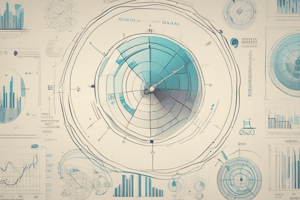Podcast
Questions and Answers
What does the height of each bar in a graph represent?
What does the height of each bar in a graph represent?
- The correlation between two variables
- The total frequency of two combined categories
- The frequency of a category (correct)
- The type of relationship between two variables
What is the primary purpose of a vertical stack graph?
What is the primary purpose of a vertical stack graph?
- To demonstrate the correlation between two variables
- To compare the frequency values for different categories
- To identify patterns in the relationship between variables
- To show the total frequency of two combined categories (correct)
What type of graph is used to compare the type of relationship between two variables?
What type of graph is used to compare the type of relationship between two variables?
- Bar graph
- Pie chart
- Scatter plot graph (correct)
- Line graph
What is an outlier in a data set?
What is an outlier in a data set?
Why is sorting data important?
Why is sorting data important?
What is the purpose of a frequency table?
What is the purpose of a frequency table?
What is the first step in creating a frequency table?
What is the first step in creating a frequency table?
What type of graph is used to show changes in a data set over time?
What type of graph is used to show changes in a data set over time?
What does a strong correlation indicate in a scatter plot graph?
What does a strong correlation indicate in a scatter plot graph?
What is the benefit of using two line graphs on the same set of axes?
What is the benefit of using two line graphs on the same set of axes?
What is the primary purpose of posing questions in the statistical process?
What is the primary purpose of posing questions in the statistical process?
What is the main difference between a population and a sample?
What is the main difference between a population and a sample?
What is the purpose of a survey?
What is the purpose of a survey?
What is the importance of a representative sample?
What is the importance of a representative sample?
What is the purpose of a questionnaire?
What is the purpose of a questionnaire?
What is the main consideration when choosing a sample size?
What is the main consideration when choosing a sample size?
What is the purpose of a recording sheet?
What is the purpose of a recording sheet?
What is the first step in the statistical process?
What is the first step in the statistical process?
Which of the following is a disadvantage of using the mean as a measure of central tendency?
Which of the following is a disadvantage of using the mean as a measure of central tendency?
What is the primary purpose of selecting a representative sample?
What is the primary purpose of selecting a representative sample?
What is the formula for calculating the range of a data set?
What is the formula for calculating the range of a data set?
Which of the following is a characteristic of the mode?
Which of the following is a characteristic of the mode?
What is the primary purpose of using a double bar graph?
What is the primary purpose of using a double bar graph?
Why is it important to ensure data collection is free from bias?
Why is it important to ensure data collection is free from bias?
What is the primary purpose of defining the population and sample?
What is the primary purpose of defining the population and sample?
What is the effect of outliers on the range of a data set?
What is the effect of outliers on the range of a data set?
What is the primary purpose of calculating the mean, median, and mode of a data set?
What is the primary purpose of calculating the mean, median, and mode of a data set?
Which of the following is a characteristic of the median?
Which of the following is a characteristic of the median?
Study Notes
Data Handling
Developing Questions
- Purpose: The first step in the statistical process involves posing questions that justify data collection and guide the data collection process.
- Impact: These questions affect the type of data needed and inform the methods used for data collection, organization, representation, and measurement.
Posing Questions
- Key Concepts:
- Population: The entire group about which data is being collected.
- Sample: A smaller subset chosen to represent the population, especially when the population is large and collecting data from the entire population is impractical.
- Survey: The process of collecting data from a sample (or population).
Considerations of Bias
- Representative Sample: Ensure the sample reflects the same features and characteristics as the population to avoid bias.
- Sample Size: Choose a sample size large enough to provide an accurate reflection of the population.
Data Collection Instruments
- Questionnaire: A document with a list of questions aimed at gathering information about a group or their opinions on a particular topic.
- Recording Sheet: A document used to record the frequency of events, the duration of events, or specific features of events.
Key Steps and Methods
- Pose Relevant Questions:
- Determine the purpose of the data collection.
- Formulate specific questions that will guide the type of data to be collected.
- Select the Data Collection Instrument:
- Choose between a questionnaire or a recording sheet based on the nature of the data and the target population.
- Define the Population and Sample:
- Identify the population for the data collection.
- Select a representative sample that reflects the characteristics of the population.
- Design the Data Collection Tool:
- For a questionnaire, include questions that cover all necessary categories (e.g., age, gender, etc.).
- For a recording sheet, design it to capture the required information effectively (e.g., number of visitors at different times of the day).
- Ensure Data Collection is Free from Bias:
- Make sure the sample accurately represents the population.
- Avoid any factors that might skew the data collection process.
- Collect and Record Data:
- Use the chosen instrument to gather data from the sample.
- Ensure accurate and consistent recording of the collected data.
Summarising Data
Measures of Central Tendency: Mean, Median, and Mode
- Mean: The sum of all values in a data set divided by the number of values.
- Median: The middle value in a sorted data set.
- Mode: The value that occurs most frequently in a data set.
Measures of Spread: Range
- Range: The difference between the highest and lowest values in a data set.
Choosing the Appropriate Measure
- Mean: Appropriate when the data set has no extreme outliers and the values are relatively evenly distributed.
- Median: Better when the data set has outliers or is skewed, as it provides a central value without being affected by extremes.
- Mode: Useful for categorical data or when identifying the most common value is important.
Impact of Outliers
- Outliers: Extreme values that differ significantly from other values in the data set.
- Effect on Measures: Outliers can skew the mean, making it unrepresentative of the data.
Steps to Summarise Data
- Calculate the Mean:
- Add all values together.
- Divide by the number of values.
- Calculate the Median:
- Sort the data set.
- Identify the middle value (or average of two middle values if even number of values).
- Identify the Mode:
- Determine the most frequently occurring value.
- Calculate the Range:
- Subtract the lowest value from the highest value.
- Compare the Measures:
- Assess the mean, median, and mode in the context of the data set.
- Consider the presence of outliers and their impact.
- Choose the measure that best represents the data.
Representing, Interpreting and Analysing Data
Types of Graphs and Their Uses
- Double Bar Graphs:
- Display two bars for each interval, with each bar representing a different category of the data.
- Height of each bar corresponds to the frequency of a category.
- Useful for comparing the frequency values for different categories over various intervals.
- Vertical Stack Graphs:
- Contain two bars for each interval, stacked vertically.
- Each part of the bar represents a different category within the data (e.g., males and females).
- Height of each section of the bar equals the frequency values recorded in the frequency table.
- Useful for showing the total frequency of two combined categories and illustrating the different components making up this total frequency.
- Pie-of-Pie and Bar-of-Pie Charts:
- Bar-of-Pie Charts: A pie chart that shows a comparison between two different categories of data, with stacked bars showing the components of each category.
- Pie-of-Pie Charts: Pie charts showing the components of the main categories in a larger pie chart.
- Useful for comparing the components of different categories and especially when each component comprises more categories.
- Two Line Graphs on the Same Set of Axes:
- Effective for showing how changes occur in a data set over time, identifying trends.
- Placing two line graphs on the same set of axes allows for comparing changes in different data sets over time and how they change relative to each other.
- Scatter Plot Graphs:
- Useful for comparing the type of relationship between two different variables or quantities when no obvious pattern is visible.
- Constructed by plotting points on a set of axes, with each point representing two different values for the variables or quantities.
- By observing the scatter of points, one can identify patterns in the relationship between variables and determine the strength of the correlation (weak or strong).
Key Concepts and Terminology
- Correlation: Describes the relationship or pattern between two variables.
- Outliers: Points in the data that deviate significantly from the other points, indicating that while a general pattern may exist, there are instances where it does not hold true.
Key Concepts
- Sorting and Arranging Data:
- Sorting data involves arranging it in a particular order.
- For numerical data, this could mean ordering from smallest to largest or vice versa.
- For categorical data, it could involve arranging alphabetically.
- Sorting helps in making sense of data by organizing it in a manageable and understandable format.
- Frequency Tables and Tallies:
- Frequency value indicates how often a particular piece of data appears in a data set.
- Frequency tables summarize how often different values appear in a data set, allowing for comparisons.
- Class intervals are used to group large sets of data into more manageable categories.
- Frequency tables often contain separate columns for different categories (e.g., males and females) and may include percentage values for easier comparison.
Studying That Suits You
Use AI to generate personalized quizzes and flashcards to suit your learning preferences.




